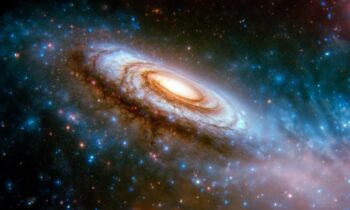Although it shields us from space radiation, Earth’s magnetic field is not as strong as we may think. At the General Assembly of the European Geosciences Union, scientists share fresh findings regarding a ‘excursion’ that occurred 41,000 years ago during which the planet was assaulted by dangerous space rays and its magnetic field weakened.
The magnetic field of Earth shields our planet from charged particles ejected by the sun and from the onslaught of cosmic radiation that streams through space. The geomagnetic field, however, is not static.
Not only does magnetic north occasionally flip, deviating from true north, which is a place that is defined geographically, but it also wobbles. North turns south and south turns north during these reversals, and the magnetic field weakens as a result.
However, there are also phenomena known as magnetic field excursions, which are brief intervals during which the magnetic field weakens and the familiar dipole (or two magnetic poles) may vanish and be replaced by many magnetic poles. Of them, the Laschamps expedition, which took place approximately 41,000 years ago, has been studied the most. Its weak magnetic field strength suggests that the Earth’s surface is less shielded from dangerous space radiation. Significant changes in the biosphere may be correlated with times of low magnetic field intensity.
By measuring cosmogenic radionuclides in cores from both ice and marine sediment, scientists may determine when the Earth’s surface was being heavily bombarded by cosmic rays. These unique isotopes are created when cosmic rays and Earth’s atmosphere interact; because they are cosmic ray products, they are cosmogenic.
Higher rates of cosmogenic radionuclide synthesis in the atmosphere should be correlated with periods of lower paleomagnetic field intensity, or less shielding. Next week, during the European Geosciences Union (EGU) General Assembly 2024, Sanja Panovska, a researcher at GFZ Potsdam, Germany, will present her results regarding the relationship between paleomagnetic field intensity and cosmogenic nuclides during the Laschamps excursion, with an emphasis on space climate.
Changes in cosmogenic radionuclides such as beryllium-10 offer a separate indicator of the paleomagnetic strength changes on Earth. In fact, Panovska discovered that the Laschamps excursion’s average beryllium-10 production rate was twice as high as current production, suggesting a relatively low magnetic field intensity and a high number of cosmic rays entering Earth’s atmosphere.
Panovska rebuilt the geomagnetic field using both datasets in an effort to extract more information from the cosmogenic radionuclide and paleomagnetic data sets. According to her reconstructions, the magnetosphere contracted during the Laschamps expedition when the field abruptly dropped, “thus reducing the shielding of our planet,” she stated.
“Understanding these extreme events is important for their occurrence in the future, space climate predictions, and assessing the effects on the environment and on the Earth system.”



